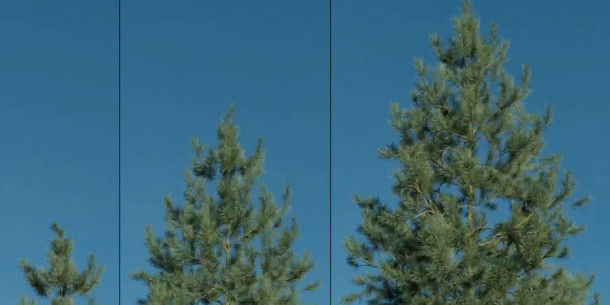F12 ships The Grove Release 8

F12 – aka developer Wybren van Keulen – has shipped The Grove Release 8, a major update to his Blender-based tool for generating biologically plausible tree models.
The release makes it possible to record the process by which The Grove simulates the growth of a tree, creating instant timelapse animations.
Other changes include new tools for art-directing the growth of trees, a number of handy new workflow features, and redesigns the software’s icons to work better with Blender 2.80.
Mimic the growth forms of real trees
The Grove takes a parametric approach to generating trees, with controls that mimic the factors determining the forms of real plants, resulting in more realistic-looking models.
Once the overall form of a tree has been set, The Grove fills in details by using ‘Twigs’: instanced geometry representing not only actual twigs, but leaves, flowers and fruit, sold separately to the core app.
The software is a Blender add-on, but the resulting textured geometry can be exported in standard file formats, including FBX and OBJ, for use in other DCC applicaitons.
The Grove can also generate wind animations for trees, which can be exported in Alembic format.
Create instant timelapse animations of trees growing
The big addition to The Grove Release 8 is support for growth animation – or at least, the option to record it.
The software has always simulated growth year by year, in order to allow users to interact with the tree during the process: for example, to prune unwanted branches manually.
The result was a timelapse animation, but in the viewport, not one that could be rendered at final quality.
That animation can now be captured and exported as an Alembic file for rendering in other software by hitting a Record button in the interface. An Interval setting controls the speed of the timelapse.
New tools for art directing tree growth, plus improved bark shading
Release 8 also updates The Grove’s reaction force system, used to grow trees into non-naturalistic art-directable shapes, to provide tighter user control over the final form.
There are now separate objects for each type of reaction force: Block, Deflect, Attract and Shade.
The algorithms by which The Grove simulates natural growth processes have also been updated, including the way tree branches turn towards light, bend under gravity, or are shed as they get older.
In addition, Release 8 improves the way that The Grove sets up shading for tree bark to mimic changes in bark colour with the age of a branch.
The software also now automatically sets up normal maps in the bark material. Van Keulen has also added normal maps to the bark textures that ship with The Grove, created in handy free tool Materialize.
Workflow improvements, UI updates and jargon busting
Workflow improvements include a new Regrow operator, which skips the normal incremental growth process for a tree, making it quicker to see the results when tweaking parameters.
The software has also been modified to play better with Blender 2.80 – a major feature of the Release 7 – with the interface icons now redesigned to display better in 2.80’s dark UI theme.
In addition, a lot of the scientific terms previously used when naming parameters have been replaced with easier-to-understand language: for example, apical twigs are now referred to as ‘end twigs’.
You can see a full list of changes – there are a lot of other smaller features – via the link below.
Pricing and availability
The Grove Release 8 is available for Blender 2.8 only, running on Windows, Linux and macOS.
The base application has an MSRP of €119 (around $133), up €10 from the previous release, although at the time of posting, it’s available at a launch discount. Individual Twigs cost €9.60 ($10.70).
Read a full list of new features in The Grove Release 8 on the product website
